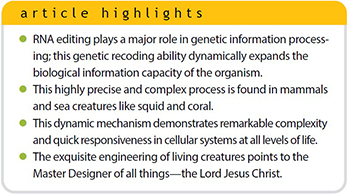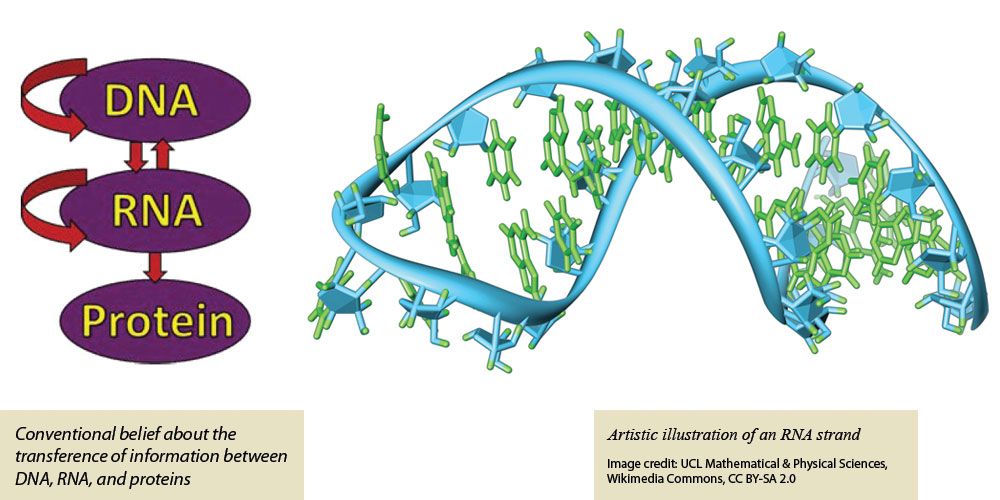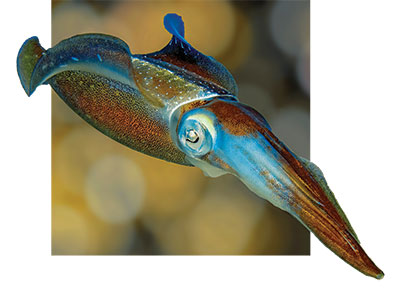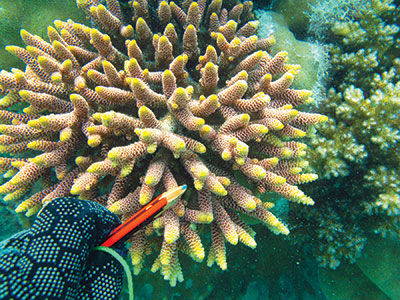 When the workings of the genome were first being discovered, the central evolutionary dogma of molecular biology claimed that genetic information passes consistently from DNA to RNA to proteins. Today we know that RNA messages can be altered by a variety of mechanisms. New studies in genetics on one of these processes, RNA editing, have revealed an unprecedented level of dynamically adaptive genome complexity that defies the conventional evolutionary paradigm.1
When the workings of the genome were first being discovered, the central evolutionary dogma of molecular biology claimed that genetic information passes consistently from DNA to RNA to proteins. Today we know that RNA messages can be altered by a variety of mechanisms. New studies in genetics on one of these processes, RNA editing, have revealed an unprecedented level of dynamically adaptive genome complexity that defies the conventional evolutionary paradigm.1

Incredible variability can be achieved through alternative splicing, but the genetic possibilities don’t stop there. RNA editing is another form of dynamic RNA alteration. Unlike alternative splicing that shuffles large chunks of DNA sequence around, RNA editing targets single bases. The most common type of RNA editing in animals involves changing an adenosine base to an inosine base (A-to-I editing). The inosine base, which isn’t part of the standard genetic code, is interpreted as a guanine base at the ribosome where proteins are made. This type of editing in both protein-coding and non-coding RNAs has been found to have profound effects on gene expression.1,3,4 Also, the alteration of RNA transcripts coding for proteins creates yet another dynamic system of diversity in the cells’ protein complement, which is called a proteome.
The process of RNA editing appears to occur as the gene is copied or transcribed (called co-transcriptional) and also after the messenger RNA (mRNA) is produced (called post-transcriptional).1 The basic type of mRNA targeted for editing is called an imperfect double-stranded RNA—a single-stranded RNA that has folded back onto itself with some mismatched bases. These targeted RNAs can be protein-coding or long non-coding RNAs.
The modification produced by RNA editing is accomplished by protein machinery called adenosine deaminases acting on RNA (ADAR) enzymes.1 The various types of ADARs, which are creature specific, edit double-stranded RNA, as noted above. This is most commonly done in non-coding regions of genes (introns) while also editing much fewer sites in coding regions with highly targeted specificity. The RNA editing in introns affects retention of the mRNA in the cell’s nucleus and the process of splicing the RNA to create a mature transcript. Incredibly, the RNA’s encoding ADAR proteins are themselves also commonly edited as part of complex feedback loops and networked interplay between RNA editing and other RNA modification systems.
Interestingly, in some creatures RNA editing is widespread among the RNA encoding of proteins involved in neurotransmission and the cellular electrical machinery that regulates cell signaling, such as ion channels in the cell membrane.1,3 These RNA edits can alter the resulting protein and can also change the splicing pattern of the mRNA when processing the transcript after it’s copied. RNA edits in ion channel proteins dynamically modulate the electrophysiological properties of the neuronal cell’s synapses and other aspects of their neuronal connections to rapidly adapt to various environmental conditions.1,3
Even more amazing from a broader and functional perspective, RNA editing affects transcripts encoding proteins involved in brain patterning for both embryo development and mature brains, neural cell identity and function, and proteins related to DNA repair.1 Thus, RNA editing is a key factor in cell neuron activity and brain cell network plasticity, which is important for daily functioning in things such as memory consolidation.
While the regulatory pathways that control RNA editing are not well understood, research studies show that RNA editing alters the structure and information content of protein-coding and long non-coding RNAs in response to changing environmental conditions and a creature’s past experience.1 In this respect, ADAR enzyme activity and target selection have been shown to be linked to cell signaling pathways.1
In regard to the adaptive, innate immune response of vertebrates, RNA editing has been shown to be involved as part of the built-in algorithm and learning machinery associated with host responses to viral infections. For example, mutations in human ADAR1 are one of the defined genetic causes of Aicardi-Goutieres syndrome, an autoinflammatory disorder characterized by spontaneous interferon production (natural defense proteins) and neurological problems.1 Mutations in human ADAR2 cause a small head and neurological disorders during development, and its deficiency in mice causes seizures and early embryo lethality.1
Clearly, RNA editing is key to an organism’s ability to develop, grow, and adapt itself in response to its environment and past life experiences. In the next part of this article, I’ll list several of the more recent studies that show how important this process is to adaptive response mechanisms.
RNA Editing in Cephalopods
Until recently, the best-studied cases of RNA editing in animals have been in mammals and flies. It was thought to occur at a fairly low level and to be mostly involved in immune responses.1 However, a 2015 study concerning squid reported that the majority of proteins studied were affected by RNA editing.3 In fact, the researchers discovered that A-to-I RNA editing had a pervasive effect on most biochemical pathways in the squid, especially those related to the nervous system. Other reports have demonstrated that RNA editing is crucial to the proper functioning of the nervous system in humans and other mammals, though at a much lower level.1,5,6

We have demonstrated that RNA editing is a major player in genetic information processing rather than an exception to the rule….The squid’s RNA editing dramatically reshaped its entire proteome—the entire set of proteins expressed by a genome, cell, tissue, or organism at a certain time.7
In a more recent squid study, the researchers used the molecular motor proteins kinesin and dynein to take a deeper look into the functional results of mRNA recoding through RNA editing.8 Both kinesin and dynein utilize cellular energy from ATP molecules to move cellular cargo down protein fiber highways called microtubules. The researchers discovered that RNA editing significantly altered both motor proteins and that this varied quite a bit between tissues and was responsive to seawater temperature.
This amazingly complex system is an engineering marvel. It enables the squid to literally recode its active genetic information “on the fly” to allow for rapid adaptive responses to changing environmental conditions. This is especially true in light of all the other intricate cellular information systems with which RNA editing interfaces.
Recent research in octopus highlighted the importance of RNA editing as an adaptive response system to changes in water temperature.9 In this study, RNA editing was documented in at least 20,000 different sites among the creature’s messenger RNAs expressed in neural tissue in response to cold water temperatures (55°F versus 72°F). The massive shift in RNA editing in response to temperature change was observed within hours in the lab, and the effects were verified by catching wild octopi in the ocean and testing their RNA.
The researchers also verified that the massive recoding of RNAs on the fly resulted in a corresponding shift in the overall protein complement (proteome) of the creature. In fact, one altered protein known as a synaptotagmin, which controls a voltage channel in neural cell membranes, was recoded in the amino acids that actually span the cell membrane. This altered the binding of calcium ions, a key chemical messenger in intercellular electrical communication. Another altered protein was a kinesin motor that moves cellular cargo down specialized protein fiber highways called microtubules, as noted above with squid.
RNA Editing in Corals
Coral reefs are a key component of ocean ecology, providing homes and habitats for a wide diversity of life. While a head of coral may look like a single organism, it’s actually a conglomeration of numerous genetically identical creatures called polyps. These organisms have been thought to represent a primitive form of multicellular animal life. In fact, evolutionary scientists allege that the first corals evolved over 400 million years ago at the earliest stages of life on Earth. But are corals actually primitive, or are they just another example of highly complex engineering?

In the coral study, scientists analyzed RNA editing in the species Acropora millepora, which is supposedly one of the most basal or primitive animals in the so-called evolutionary tree of life. The researchers focused on reproductive cells, or gametes (sperm and egg), where RNA editing was believed to play an important role. Surprisingly, it was discovered that the RNA editing patterns in the corals resembled those found in mammals. The patterns are largely involved in transposable element sequences that, when transcribed, readily form double-stranded RNAs that fold back onto themselves. In fact, they found over 500,000 sites in coral transcripts where RNA editing had altered the sequence. The RNA editing levels were especially increased during spawning and in newly released gametes.

RNA Editing in Mammals
As far as the adaptive engineering of RNA editing goes, the greatest research progress has been in marine creatures that live in very challenging ocean environments, as noted above with cephalopods and corals. However, a 2018 study in mammals illustrated how this system also works in land creatures.11
While cephalopods and corals are ectothermic marine animals whose body temperature mirrors the surrounding temperature, hibernating ground squirrels provide a unique opportunity to investigate RNA editing in a heterothermic mammal, whose body temperature is internally determined. Remarkably, ground squirrels exhibit a unique physiology where body temperature varies over 86°F and can be maintained at a low temperature of 41°F for many days during hibernation and torpor. Torpor is a state of decreased physiological activity associated with hibernation that’s characterized by reduced body temperature and slow metabolic rates. Thus, torpor is a highly specialized and adaptive system that enables some animals to maintain physiological activity during periods of reduced food availability in winter.
In this study, researchers profiled the transcriptome (total RNA in a given tissue) in three brain regions at six different physiological states.11 The goal was to evaluate whether RNA editing is a mechanism that during hibernation facilitates neurological tissue protection in response to cold temperatures. The researchers identified 5,165 RNA sites in 1,205 genes that had dynamically increased RNA editing after the squirrels were subjected to the cold for an extended period. Additionally, the RNA editing was found to positively correlate with increasing cold exposure. The overall conclusion was that RNA editing at low body temperatures provided a dynamic neuroprotective mechanism during torpor in mammalian hibernation.
Conclusion
RNA editing promotes transcriptome diversity by recoding and expanding the coding capacity of the genome, typically as a controlled response to changed environmental conditions. The most common type of RNA editing is A-to-I editing in which the I is read as a guanine at the ribosomal machinery that translates proteins.
The chief piece of cellular machinery involved in this recoding reaction is an adenosine deaminase, known as the ADAR family of enzymes, that acts on the mRNA. At present, most research has revolved around RNA editing in response to temperature changes associated with cold acclimation. In ectothermic organisms, including Drosophila and Cephalopoda, where body temperature mirrors ambient temperature, decreases in environmental temperature lead to increases in A-to-I RNA editing and cause amino acid recoding events that are thought to be adaptive responses to temperature fluctuations. In addition, RNA editing is also being shown to be important in cold acclimation of hibernating mammals.
Evolution pictures living organisms as passive forms being acted on and shaped by outside forces. But the more researchers delve into life’s inner workings, the more they find innate, exquisitely engineered systems that enable creatures to adapt and respond to changes around them. Our world declares the wonders of our Creator, the Lord Jesus Christ.
References
- Mattick, J. and P. Amaral. 2023. RNA, the Epicenter of Genetic Information: A New Understanding of Molecular Biology. Boca Raton, FL: CRC Press.
- Roy, B., L. M. Haupt, and L. R. Griffiths. 2013. Review: Alternative Splicing (AS) of Genes As An Approach for Generating Protein Complexity. Current Genomics. 14 (3): 182–194. DOI:10.2174/1389202911314030004.
- Alon, S. et al. The majority of transcripts in the squid nervous system are extensively recoded by A-to-I RNA editing. eLife. Posted on elifesciences.org February 4, 2015. DOI: 10.7554/eLife.05198.
- Chen, L. L. and G. G. Carmichael. 2008. Gene regulation by SINES and inosines: biological consequences of A-to-I editing of Alu element inverted repeats. Cell Cycle. 7 (21): 3294–3301.
- Slotkin, W. and K. Nishikura. 2013. Adenosine-to-inosine RNA editing and human disease. Genome Medicine. 5 (11): 105. DOI: 10.1186/gm508.
- Tariq, A. and M. F. Jantsch. 2012. Transcript Diversification in the Nervous System: A to I RNA Editing in CNS Function and Disease Development. Frontiers in Neuroscience. 6: 99. DOI: 10.3389/fnins.2012.00099.
- Make Like a Squid and Transform. Tel Aviv University American Friends news release. Posted on aftau.org February 12, 2015.
- Rangan, K. J. and S. L. Reck-Peterson. 2023. RNA Recoding in Cephalopods Tailors Microtubule Motor Protein Function. Cell. 186 (12): 2531–2543.
- Birk, M. A. et al. 2023. Temperature-dependent RNA Editing in Octopus Extensively Recodes the Neural Proteome. Cell. 186 (12): 2544–2555.
- Porath, H. T. et al. 2017. A-to-I RNA Editing in the Earliest-Diverging Eumetazoan Phyla. Molecular Biology and Evolution. 34 (8): 1890–1901.
- Riemondy, K. A. et al. 2018. Dynamic temperature-sensitive A-to-I RNA editing in the brain of a heterothermic mammal during hibernation. RNA. 24 (11): 1481–1495.
* Dr. Tomkins is Research Scientist at the Institute for Creation Research and earned his Ph.D. in genetics from Clemson University.













